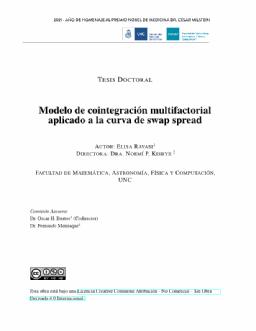| dc.contributor | Bustos, Oscar Humberto | |
| dc.contributor.advisor | Kisbye, Noemí Patricia | |
| dc.contributor.author | Ravasi, Elisa | |
| dc.date.accessioned | 2022-04-27T16:41:52Z | |
| dc.date.available | 2022-04-27T16:41:52Z | |
| dc.date.issued | 2021 | |
| dc.identifier.uri | http://hdl.handle.net/11086/24378 | |
| dc.description | Tesis (Doctor en Matemática)--Universidad Nacional de Córdoba, Facultad de Matemática, Astronomía, Física y Computación, 2021. | es |
| dc.description.abstract | En esta tesis se trabajó en cómo capturar los movimientos estructurales de la curva swap spread a través de un modelo dinámico de factores donde se asume que cada factor: nivel, pendiente y curvatura están cointegrados con variables macroeconómicas que los impulsan: los valores respaldados por hipotecas (MBS por sus siglas en inglés) y el tipo de cambio dólar/yen (USD/JPY). Se llevó a cabo una comparación entre un modelo autorregresivo vectorial (VAR) compuesto por factores y drivers, y un modelo de corrección de errores vectorial (VECM) que asume que esos factores y drivers son integrados y hay una o más relaciones de cointegración entre ellos. La comparación se realizó simulando las series de tiempo para cada modelo y luego estudiando su eficiencia en la predicción de cada factor. Mostramos que asumir integrabilidad de factores y drivers así como una cointegración entre estas variables mejora el desempeño del modelo original (VAR). Finalmente se vio que este enfoque también permite estudiar el impacto que diferentes drivers pueden tener sobre un factor en particular más que en cada punto de la curva, dando una comprensión más global del comportamiento de la curva swap spread. | es |
| dc.description.abstract | In this thesis we study how to capture the structural movements of the swap spread curve through a factor dynamic model in which it is assumed that each factor: level,slope and curvature are cointegrated with macroeconomic variables that drive them: the duration of the Mortgage-baked securities (MBS) and the current exchange rate US dollar to Japanese YEN (USD/JPY). We make a comparison between a vector autoregressive model (VAR) composed by series of factors and drivers, and a vector error correction model (VECM) that assumes integrability of these series and that there is one or more cointegrating relationship. The comparison is carried out by simulating the time series for each model and then studying their efficiency by predicting each factor. We show that assuming cointegration between these variables improves the performance of the original (VAR) model. Finally we can study the impact that different drivers may have on a factor rather than at each point of the curve, giving a global understanding of the behavior of the swap spread curve. | en |
| dc.language.iso | spa | es |
| dc.rights | Attribution-NonCommercial-NoDerivatives 4.0 Internacional | * |
| dc.rights.uri | http://creativecommons.org/licenses/by-nc-nd/4.0/ | * |
| dc.subject | Curva swap spread | es |
| dc.subject | Macroeconomía | es |
| dc.subject | Nelson y Siegel dinámico | es |
| dc.subject | Cointegración | es |
| dc.subject | Aplicaciones de la estadísitca a la ciencia actuarial y a la matemática financiera | es |
| dc.subject | Applications of statistics to actuarial sciences and financial mathematics | en |
| dc.title | Modelo de cointegración multifactorial aplicado a la curva de swap spread | es |
| dc.type | doctoralThesis | es |
| dc.description.fil | Fil: Ravasi, Elisa. Universidad Nacional de Córdoba. Facultad de Matemática, Astronomía, Física y Computación; Argentina. | es |





